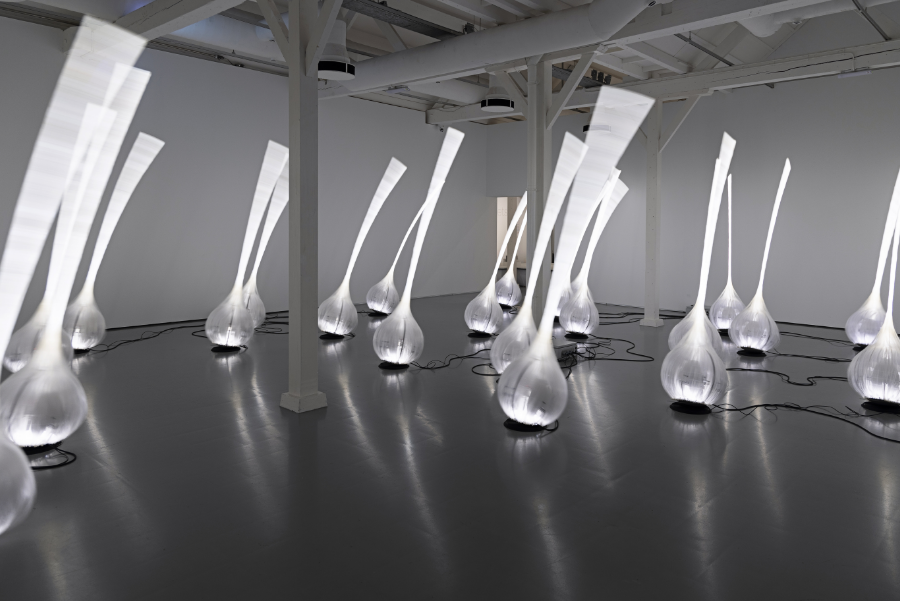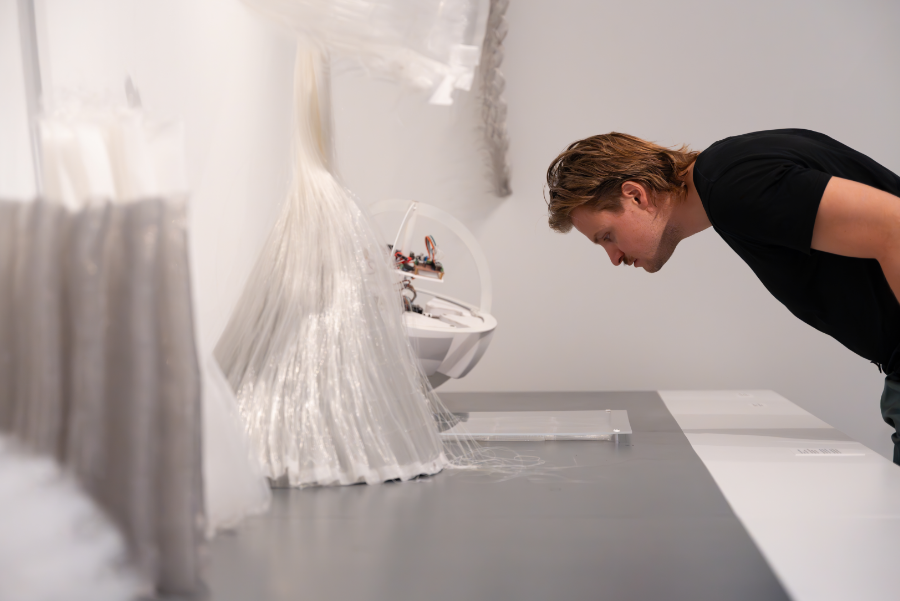The exhibition Is it alive? features the spectacular results of multi-year collaborations with the TextielLab. Artists and product developers worked together to find the perfect balance between textile ‘skins’ and the mechanical systems that control them. “The works touch you because they look so natural,” says curator Sjouk Hoitsma.
Twenty-five tall blades of grass light up and start moving as soon as you enter the room. The wind catches the blades as you walk through them. In fact, the wind is you. These days, installations and works of art are frequently labelled ‘interactive’, but in this case the term is completely appropriate: ‘I am storm’ by DRIFT physically responds to the presence of visitors. They influence the landscape and vice versa, creating a magical, almost meditative spectacle of rippling stems. The installation is having its world premiere at the TextielMuseum in Is it alive? and sets the tone for an exhibition that celebrates the crossover between art, technology and nature. Textiles are an ideal medium for this crossover, which becomes clear when walking through the various rooms. Besides DRIFT, works by Tanja Smeets, Bart Hess, Philip Beesley and Iris van Herpen are also on show.

“I am Storm” by DRIFT. Photo: Josefina Eikenaar
Multi-year voyage of discovery
In Is it alive?, textiles have assimilated other materials and techniques to come to life. Sensors, processors, lighting elements, motors and other high-tech modules are hidden beneath organic-looking layers of woven, plaited, knitted and laser-cut fabrics. “Haute couture,” curator Sjouk Hoitsma calls it; tailor-made for the visual effect the artists had in mind. Through their art, they seek a connection with nature – not as something to be looked at from a distance but to feel part of. The custom work for three of the installations in the exhibition was realised in the TextielLab, in a multi-year collaboration between artists and product developers. DRIFT, Tanja Smeets and Bart Hess returned to the lab several times to build on their findings and make additions for the next experiment.
“Natural movements remind the body how to adapt to the environment.”
Lonneke Gordijn (DRIFT)
Natural choreography
This stepwise development process provides innovative insights for both artists and product developers. For example, Lonneke Gordijn and Ralph Nauta from DRIFT have been working in intensive sprints with the TextielLab since 2020, researching building with textiles. Their experiments with weaving self-supporting structures formed the basis of a specialised R&D programme in the lab focused on weaving with metal. For ‘I am Storm’, DRIFT ultimately did not choose metal but rather a polyester monofilament to produce the rippling grass they wanted. “They really manipulated the technology to achieve that,” says Hoitsma. Sensory control modules were designed especially for this project to control each blade of grass individually in a carefully composed choreography. The transparent monofilament skin for the globe and blade were made from the same square woven fabric and shaped using folds and pulling threads. During this process, the importance of keeping the illuminated blades flexible during the sweeping movement became apparent. It would look too wooden otherwise, says Hoitsma: “Only when the movement and appearance as a whole looks natural does it really touch you.”

Phases of the DRIFT development process. Photo: Patty van den Elshout
Leaf catchers
The artists in Is it alive? each used technology in their own way to evoke emotions. For example, Tanja Smeets’ alien landscape causes mild anxiety when you become aware that you are being watched by strange creatures as you pass. To achieve this effect, Smeets added a living layer to the work ‘Nebula and the Soft Machine’ previously created in the TextielLab. You have to look twice to see that dozens of leaf catchers and tie wraps have been assimilated into a slow-moving world of laser-cut felt and whimsically knitted growths. The subtle movements and resulting crackling sound they create cause goosebumps and suggest that the textile mass is teeming with life.
“Biomimicry allows me to look at the power of shapes in nature.”
Iris van Herpen
Breathing textiles
In the next room, the bald, wriggling shapes with hairy tails and breathing lungs in an incubator produce an even more uncomfortable feeling. These interactive skins by Bart Hess, which spasm excitedly as viewers approach, were developed in the lab in 2016. ‘STIMULUS: cord reflexes’ were the first interactive works in the museum collection, for which Hess used the traditional cord braiding machine in the lab in a completely new way. The works are powered by Lego motors, which sounds more reassuring than it looks. Regain your sense of calm in the final room designed by Philip Beesley and Iris van Herpen, where a ‘coiled’ network of reactive cell structures evokes a poetic feeling. Equally evocative is the illuminated dress, whose shadow can be seen growing and morphing on the wall behind the mannequin. “The dress is dreaming its own future,” says Beesley. “It’s definitely alive.”

‘STIMULUS: cord reflexes’ by Bart Hess. Photo: Patty van den Elshout / Installation by Iris van Herpen and Philip Beesley. Photo: Josefina Eikenaar
Visit the exhibition “Is it Alive?” from October 14, 2023 to April 7, 2024.
Text: Willemijn de Jonge